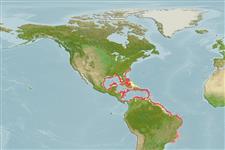Teleostei (teleosts) >
Eupercaria/misc (Various families in series Eupercaria) >
Latilidae (Deepwater tilefishes)
Etymology: Caulolatilus: Greek, kaulos = stem, stalk + Latin, latus = wide (Ref. 45335).
More on author: Valenciennes.
Environment: milieu / climate zone / depth range / distribution range
Ecology
Marine; demersal; depth range 76 - 244 m (Ref. 5217). Tropical; 35°N - 24°S
Western Atlantic: North Carolina and Dry Tortugas, Florida (USA), major part of the Antilles to Rio de Janeiro, Paraná (Ref. 47377) and Sao Paulo, Brazil (Ref. 7251). Throughout Caribbean (Dooley, pers. comm., Ref. 26938).
Size / Weight / Age
Maturity: Lm ? range ? - ? cm
Max length : 60.0 cm TL male/unsexed; (Ref. 7251); common length : 44.0 cm TL male/unsexed; (Ref. 9626)
Inhabits rubble bottoms. Feeds mainly on crustaceans and other invertebrates; occasionally on small fishes. Flesh not appreciated (Ref. 5217). Minimum depth from Ref. 47377. Traded as an aquarium fish at Ceará, Brazil (Ref. 49392).
Life cycle and mating behavior
Maturity | Reproduction | Spawning | Eggs | Fecundity | Larvae
Dooley, J.K., 1978. Systematics and biology of the tilefishes (Perciformes: Branchiostegidae and Malacanthidae) with descriptions of two new species. NOAA Tech. Rep. NMFS Circ. No. 411:1-78. (Ref. 8991)
IUCN Red List Status (Ref. 130435: Version 2024-1)
Threat to humans
Harmless
Human uses
Fisheries: commercial; gamefish: yes; aquarium: commercial
Tools
Special reports
Download XML
Internet sources
Estimates based on models
Preferred temperature (Ref.
123201): 17.1 - 25.2, mean 21.3 °C (based on 78 cells).
Phylogenetic diversity index (Ref.
82804): PD
50 = 0.5005 [Uniqueness, from 0.5 = low to 2.0 = high].
Bayesian length-weight: a=0.00741 (0.00437 - 0.01257), b=3.10 (2.94 - 3.26), in cm total length, based on LWR estimates for this species & (Sub)family-body (Ref.
93245).
Trophic level (Ref.
69278): 3.6 ±0.51 se; based on food items.
Resilience (Ref.
120179): Medium, minimum population doubling time 1.4 - 4.4 years (Preliminary K or Fecundity.).
Fishing Vulnerability (Ref.
59153): Moderate vulnerability (44 of 100).
Climate Vulnerability (Ref.
125649): High to very high vulnerability (66 of 100).
Nutrients (Ref.
124155): Calcium = 86.4 [58.1, 166.7] mg/100g; Iron = 1.05 [0.67, 1.69] mg/100g; Protein = 16.6 [14.3, 19.6] %; Omega3 = 0.237 [0.153, 0.371] g/100g; Selenium = 73.4 [37.9, 144.5] μg/100g; VitaminA = 28.3 [10.5, 78.0] μg/100g; Zinc = 0.968 [0.698, 1.358] mg/100g (wet weight);
